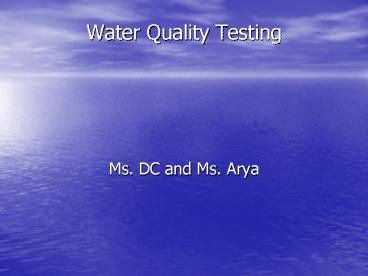Water Quality Testing - PowerPoint PPT Presentation
1 / 16
Title:
Water Quality Testing
Description:
Testing Your Water for Phosphates. 1. Using the 25 mL from turbidity testing, pour 5 mL into a test tube. ... Results tell you how basic or acidic the water is ... – PowerPoint PPT presentation
Number of Views:723
Avg rating:3.0/5.0
Title: Water Quality Testing
1
Water Quality Testing
- Ms. DC and Ms. Arya
2
What should we test our water for??
3
What is Turbidity?
- Measurement of how clear the water is
- Unclear water is said to be turbid.
- Turbidity is caused by matter such as clay, silt,
and other material in the water - Could be the result of soil erosion, run-off, and
algal blooms
4
Test Your Water Turbidity
- 1. Pour 25 mL of water into the turbidity beaker.
- 2. Use the Secchi disk to measure turbidity
5
What are Phosphates?
- Phosphates come from phosphorus, a plant nutrient
- Frequently found in run-off from construction
- Used as a fertilizer for landscaping
6
Phosphates
- Can cause algal blooms which remove oxygen from
the water - Over HALF of all phosphates in water come from
household detergents
7
Testing Your Water for Phosphates
- 1. Using the 25 mL from turbidity testing, pour 5
mL into a test tube. - 2. Add one Phosphorus TesTab.
- 3. Cap the tube and mix until tablet dissolves.
- Wait for 5 minutes.
8
What are nitrates?
- Nitrates come from nitrogen, a nutrient that
helps plants grow - High levels of nitrates cause aquatic plant and
algal blooms which remove oxygen from water - Unpolluted waters usually contain about 4 parts
per million of nitrates - Above 40 parts per million is unsafe for drinking
9
Nitrates
- Nitrates get into our watershed by
- Human and Animal wastes
- Decomposing organic matter
- (matter that was once living breaking down)
- Lawn and crop fertilizer run-off
10
Test Your Water for Nitrates
- 1. Using the water from the turbidity experiment,
pour 5 mL of water into a clean test tube - 2. Add one Nitrate 1 TesTab. Cap the tube and
mix until tablet dissolves - 3. Add one Nitrate 2 CTA TesTab. Cap tube and
mix. - 4. Wait 5 minutes.
11
What is Dissolved Oxygen?
- Just like animals on land, aquatic animals need
oxygen to live - Oxygen is dissolved in the water
- Algal blooms use up all the oxygen leaving little
for the animals in the water
12
Testing Your Water for Dissolved Oxygen
- 1. Pour 5 mL of water into the test tube.
- 2. Put one TesTab into the tube and dissolve the
tablet. - 3. Compare the color the water turns to the chart.
13
What is pH?
- One of the most common water tests
- Results tell you how basic or acidic the water is
- A pH range of 6.5 to 8.2 is healthy for most
organisms - Blue Crabs need a pH of 8.0
- Rapidly growing algae can increase the pH of water
14
Measure Your Waters pH
- 1. Pour 10 mL from the turbidity experiment into
a test tube - 2. Add one pH Wide Range TesTab
- 3. Cap the tube and mix until the tablet is
dissolves. - 4. Compare to color chart.
15
Coliform Testing
- Coliform is a group of bacteria that is commonly
found in animal feces - High coliform amounts can result in disease in
aquatic animals as well as people swimming in
that water
16
Testing Your Water for Coliform
- Write your name on your nutrient agar plate
- Dip a sterile swab into your water
- Streak your nutrient agar plate
- Put your plate in the middle of the table
- Ms. DC will put your plate in an incubator (37C)
overnight. You will look at your plates tomorrow.

